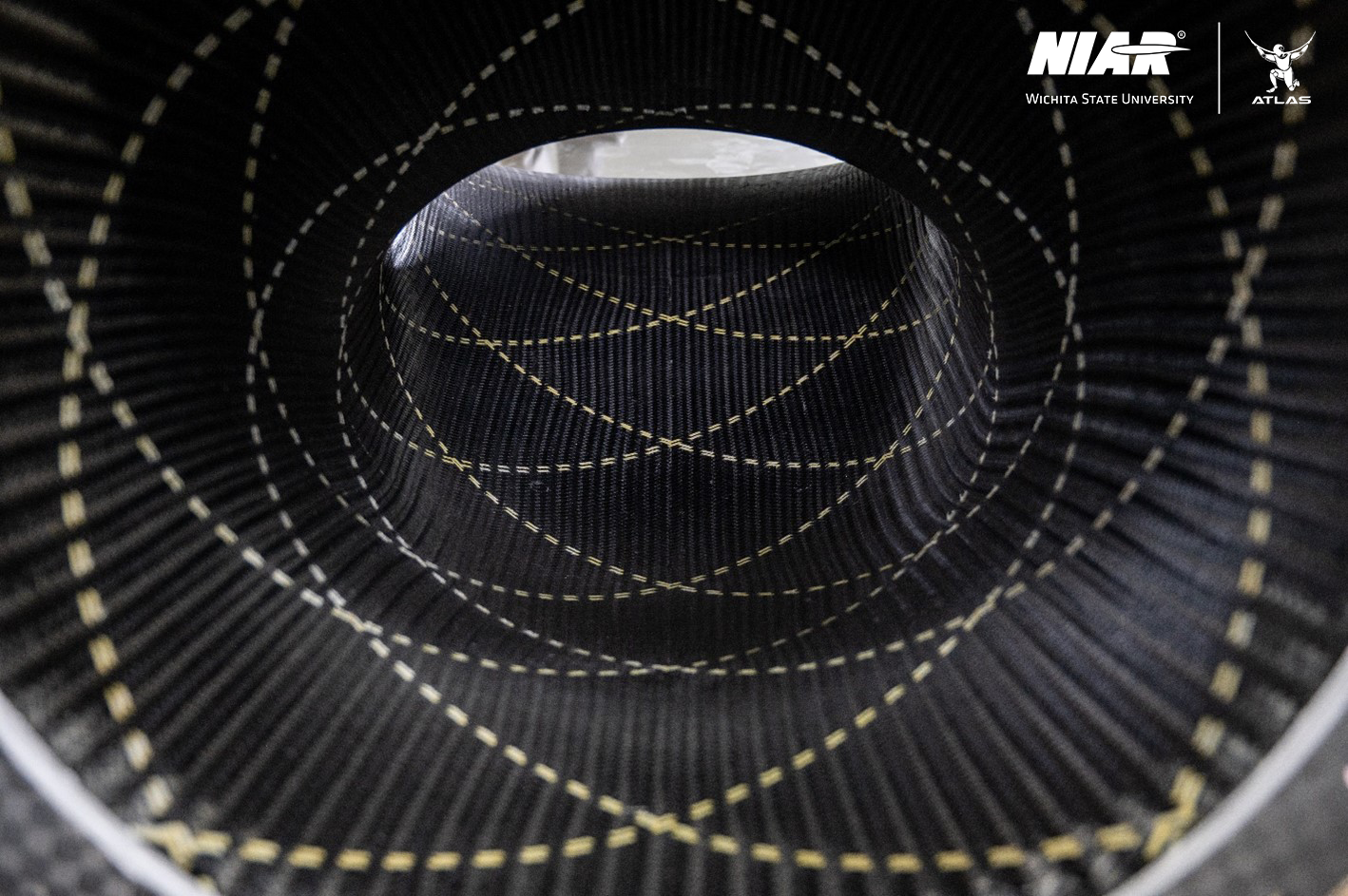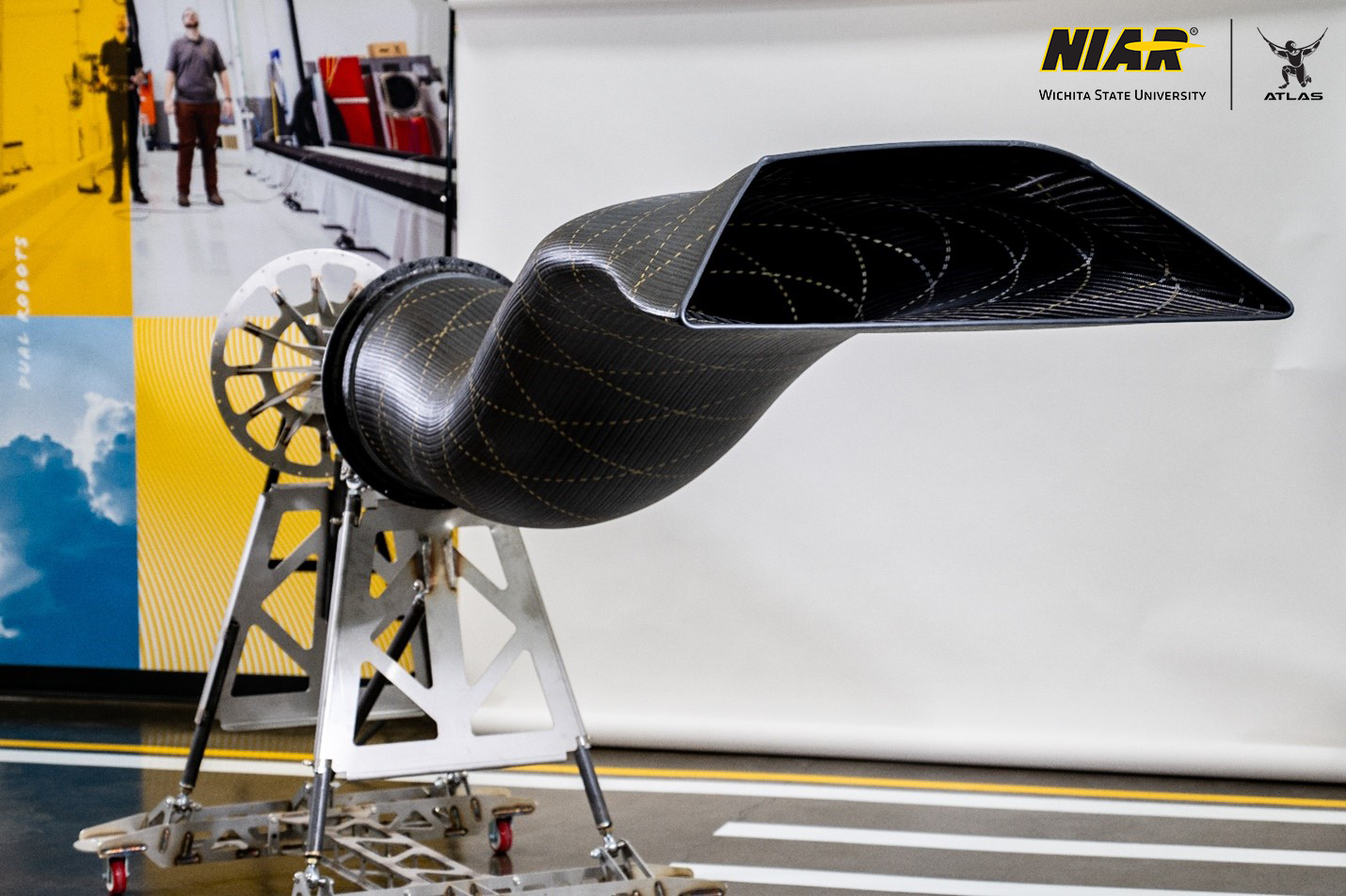
Wichita State University’s National Institute for Aviation Research (NIAR) recently partnered with A&P Technology and Fiber Dynamics to build a composite inlet duct for a combat drone aircraft using a novel overbraiding technology.
Researchers with NIAR’s Advanced Technologies Lab for Aerospace Systems (ATLAS) designed the inlet duct as a part of a manufacturing demonstrator called Frankenstein (FS-19), which is a 30-foot unmanned combat aircraft. The project, part of the Air Force Research Laboratory’s (AFRL) Manufacturing for Affordable Sustainable Composites (MASC) program, is a proof-of-concept for low-cost, high-rate production worthiness.
“This manufacturing demonstrator is intended to generate a cost model based on manufacturing data that includes various materials and manufacturing and assembly methods, allowing manufacturers to use the information for on-demand flexible manufacturing and assembly of composite structures based on volume, cost, weight, and mission requirements,” said Waruna Seneviratne, ATLAS Director.
The complex curvature of the inlet duct demanded a novel approach to manufacture. Placement of tows using automated tape-laying is limited due to the radius of curvature; and hand placement of prepreg would result in excessive cutting and splicing. The overbraiding technology was developed by A&P Technology in Cincinnati and was identified by AFRL as a key process for high-rate production of aircraft parts. The technology is capable of producing multiple duct preforms per shift.
The demonstrator inlet duct is approximately eight feet long with perimeters ranging from 56.5-96.6 inches. Fiber Dynamics created a melt-out mandrel using its ThermocoreTM Lost Core Tooling System. A&P Technology used this system to overbraided five layers of triaxial braid at a constant thickness of .10” thick, resulting in angle changes along the length of the part ranging from 55-74°. There were no cuts or splices created during the overbraiding process, and the precise control of fiber angle provides consistently high part-to-part repeatability.
A&P Technology and Fiber Dynamics are working through the MASC research program to develop a path to certification of overbraided structures. NIAR and A&P previously partnered to generate FAA-approved design allowables for 2x2 biaxial braid for resin transfer molding of control surfaces of a Raytheon Premier I Part 23 business jet. By creating a certification method for a more automated layup process like overbraiding, MASC continues its work to create affordable and sustainable methods of manufacture.
The proposed path to certification includes establishing a one-point certification method that fully qualifies a nominal angle with laminate analysis predictions for angle changes, similar to Advanced Fiber Placement techniques and Laminate Plate Theory rotations of flat fabrics. Once qualified, predictions will be validated through simplified bridge testing of predicted properties at various angles.
About NIAR
The National Institute for Aviation Research (NIAR) at Wichita State University provides
research, design, testing, certification and training to the aviation, defense, manufacturing,
and related industries. NIAR has a $350 million annual budget, a staff of 1,200 and
nearly two million square feet of laboratory and office space in six locations across
the city of Wichita, the Air Capital of the World. Areas of expertise include Additive
& Advanced Manufacturing; Advanced Coatings; Aerodynamics; Ballistics and Crash Dynamics;
Composites and Advanced Materials; Digital Twin; Environmental and Electromagnetic
Test; eXtended Reality; Flight Simulation; Full-Scale Structural Test; Non-Destructive
Test; Sustainment; Reverse Engineering; Robotics/Automation and Virtual Engineering.
NIAR is a department within the division of Industry and Defense Programs at Wichita
State. www.niar.wichita.edu
About A&P Technology
A&P Technology is a seventh-generation, family-owned, world-leading producer of precision
braided textiles. It began as an R&D division of Atkins & Pearce, America's largest
and oldest braiding company and a dominant force in textile braid markets worldwide.
From the beginning, A&P concentrated its research efforts on the development of state-of-the-art
braiding machinery aimed at furthering the use of braid within the composites industry.
This tradition continues today with our modern facilities, industry-leading research
and development, and manufacture of the world's largest and most technologically advanced
braiding machinery. This machinery includes a line of Megabraiders™, the largest braiding
machinery in existence, which meet composite designers' needs for braided reinforcements
of large diameters with small unit cells. www.braider.com
About Fiber Dynamics
Fiber Dynamics stands at the forefront of Resin Transfer Molding, offering a comprehensive
suite of services for the production of highly engineered composite structures. The
Wichita-based facility is equipped to handle the entire lifecycle of composite components,
from conceptual design and certification to high-volume production, serving diverse
industries with turnkey solutions. Fiber Dynamics employs proven methodologies to
deliver superior quality, innovative, and cost-effective solutions. The pioneering
Thermocore™ Lost Core Tooling System enables the creation of exceptionally complex
parts, meeting the rigorous demands of aerospace applications. Fiber Dynamics designs,
tests, and manufactures critical components for premier business jets, military aircraft,
spacecraft, Advanced Air Mobility and beyond. fiberdynamics.net


